Experimental Demonstration of High-Sensitivity Underwater Optical Wireless Communication Based on Photocounting Receiver
Abstract
:1. Introduction
2. Operation Principle
3. System Model
3.1. LED Transmitter
3.2. Underwater Channel
3.3. Photocounting Receiver
4. Experiment and Results
4.1. Experimental Setup and Paraeters
4.2. Attenuation Coefficient Measurement
4.3. Measured BER Performance
4.4. The Predicted Performance Based on the Proposed System
5. Discussion
5.1. Pointing and Alignment
5.2. Multipath Interference
6. Conclusions
Author Contributions
Funding
Institutional Review Board Statement
Informed Consent Statement
Data Availability Statement
Conflicts of Interest
References
- Stojanovic, M. Recent advances in high-speed underwater acoustic communications. IEEE J. Ocean. Eng. 1996, 21, 125–136. [Google Scholar] [CrossRef]
- Duntley, S. Light in the sea. OSA J. Opt. Soc. Am. 1963, 53, 214–233. [Google Scholar] [CrossRef]
- Kaushal, H.; Kaddoum, G. Underwater optical wireless communication. IEEE Access 2016, 4, 1518–1547. [Google Scholar] [CrossRef]
- Shen, J.; Wang, J.; Chen, X.; Zhang, C.; Kong, M.; Tong, Z.; Xu, J. Towards power-efficient long-reach underwater wireless optical communication using a multi-pixel photon counter. OSA Opt. Exp. 2018, 26, 23565–23571. [Google Scholar] [CrossRef] [PubMed]
- Rao, H.; Fletcher, A.; Hamilton, S.; Hardy, N.; Moores, J.; Yarnall, T. A burst-mode photon counting receiver with automatic channel estimation and bit rate detection. In Proceedings of the SPIE Conference LASE, San Francisco, CA, USA, 13 April 2016; p. 97390H. [Google Scholar]
- Xu, F.; Khalighi, M.; Bourennane, S. Impact of different noise sources on the performance of PIN-and APD-based FSO receivers. In Proceedings of the 11th International Conference on Telecommunications, Graz, Austria, 15–17 June 2011; pp. 211–218. [Google Scholar]
- Wang, P.; Li, C.; Xu, Z. A cost-efficient real-time 25 Mb/s system for LED-UOWC: Design, channel coding, FPGA implementation, and characterization. IEEE/OSA J. Lightw. Technol. 2018, 36, 2627–2637. [Google Scholar] [CrossRef]
- Kahn, J.-M.; Barry, J.-R. Wireless infrared communication. Proc. IEEE 1997, 85, 265–298. [Google Scholar] [CrossRef] [Green Version]
- Kopelevich, V. Small-parametric model of the optical properties of seawater. In Ocean Optics, I: Physical Ocean Optics; Oxford University Press: Moscow, Russia, 1983; pp. 208–234. [Google Scholar]
- Haltrin, V.; Khalturin, V. Propagation of light in sea depth. In Optical Remote Sensing of the Sea and the Influence of the Atmosphere; Academy of Sciences of GDR: Berlin, Germany, 1985; Chapter 2; pp. 20–62. [Google Scholar]
- Haltrin, V.-I.; Kattawar, G. Self-consistent solutions to the equation of transfer with elastic and inelastic scattering in oceanic optics: I. Model. OSA Appl. Opt. 1993, 32, 5356–5367. [Google Scholar] [CrossRef] [PubMed]
- Haltrin, V.-I. Chlorophyll-based model of seawater optical properties. OSA Appl. Opt. 1999, 38, 6826–6832. [Google Scholar] [CrossRef] [PubMed] [Green Version]
- Prieur, L.; Sathyendranath, S. An optical classification of coastal and oceanic waters based on the specific spectral absorption curves of phytoplankton pigments, dissolved organic matter, and other particulate materials. Limnol. Oceanogr. 1981, 26, 671–689. [Google Scholar] [CrossRef]
- Carder, K.-L.; Stewart, R.-G.; Harvey, G.-R.; Ortner, P.-B. Marine humic and fulvic acids: Their effects on remote sensing of ocean chlorophyll. Limnol. Oceanogr. 1989, 34, 68–81. [Google Scholar] [CrossRef]
- Hawes, S.-K.; Carder, K.-L.; Harvey, G.-R. Quantum fluorescence efficiencies of fulvic and humic acids: Effect on ocean color and fluorometric detection. In Proceedings of the SPIE in Ocean Optics XI, San Diego, CA, USA, 31 December 1992; Volume 1750, pp. 212–223. [Google Scholar]
- Haltrin, V.-I. One-parameter model of seawater optical properties. In Proceedings of the Ocean Optics XIV CD-ROM, Kailua-Kona, HI, USA, 10–13 November 1998; pp. 1–7. [Google Scholar]
- Gabriel, C.; Khalighi, M.-A.; Bourennane, S.; Léon, P.; Rigaud, V. Monte-Carlo-based channel characterization for underwater optical communication systems. J. Opt. Commun. Netw. 2013, 5, 1–12. [Google Scholar] [CrossRef] [Green Version]
- Ishimaru, A. Wave Propagation and Scattering in Random Media; IEEE Press: Piscataway, NJ, USA, 1997. [Google Scholar]
- Bohren, C.-F.; Huffman, D.-R. Absorption and Scattering of Light by Small Particles; Wiley: Hoboken, NJ, USA, 1988. [Google Scholar]
- Pontbriand, C.; Farr, N.; Ware, J.; Preisig, J.; Popenoe, H. Diffuse high-bandwidth optical communications. In Proceedings of the IEEE OCEANS, Quebec City, QC, Canada, 15–18 September 2008; pp. 15–18. [Google Scholar]
- Ning, J.; Gao, G.; Zhang, J.; Peng, H.; Guo, Y. Adaptive receiver control for reliable high-speed underwater wireless optical communication with photomultiplier tube receiver. IEEE Photonics J. 2021, 13, 1–7. [Google Scholar] [CrossRef]
- Jaruwatanadilok, S. Underwater wireless optical communication channel modeling and performance evaluation using vector radiative transfer theory. IEEE J. Sel. Areas Commun. 2008, 26, 1620–1627. [Google Scholar] [CrossRef]
- Jamali, M.-V.; Salehi, J.-A.; Akhoundi, F. Performance studies of underwater wireless optical communication systems with spatial diversity: MIMO scheme. IEEE Trans. Commun. 2016, 65, 1176–1192. [Google Scholar] [CrossRef] [Green Version]

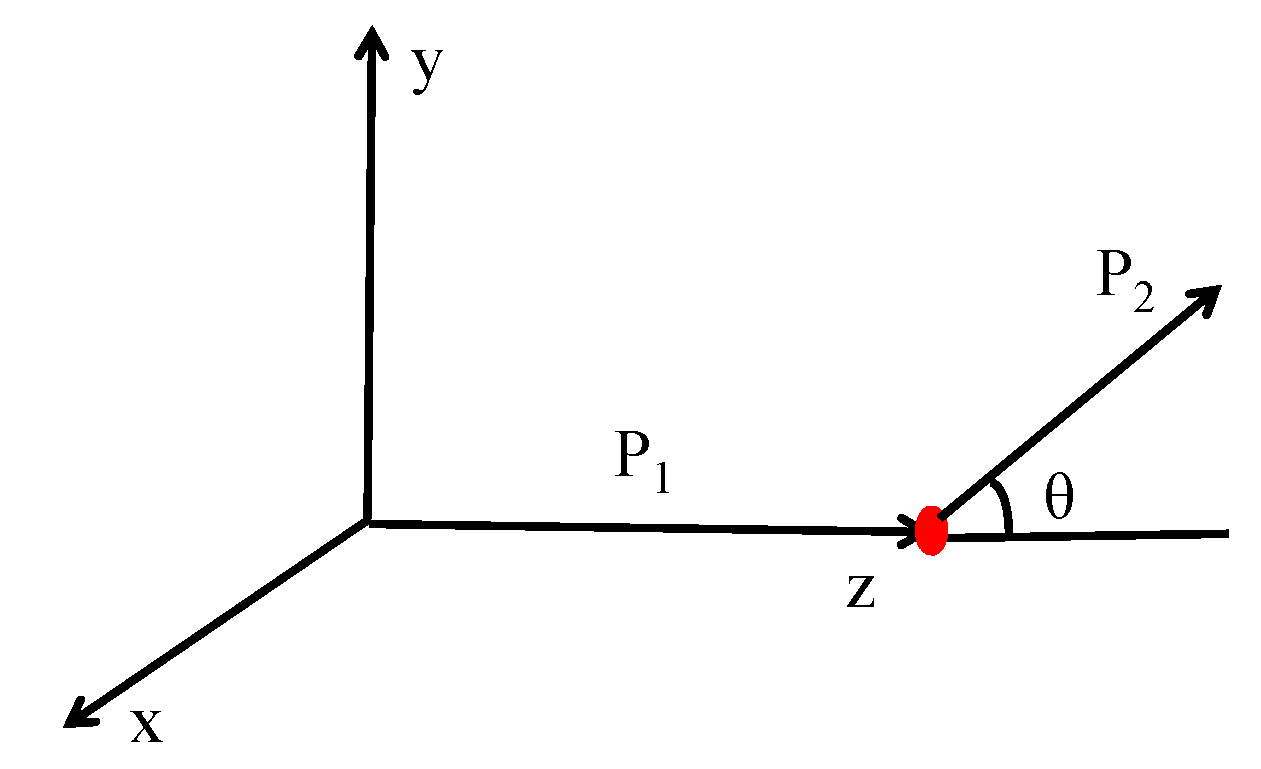
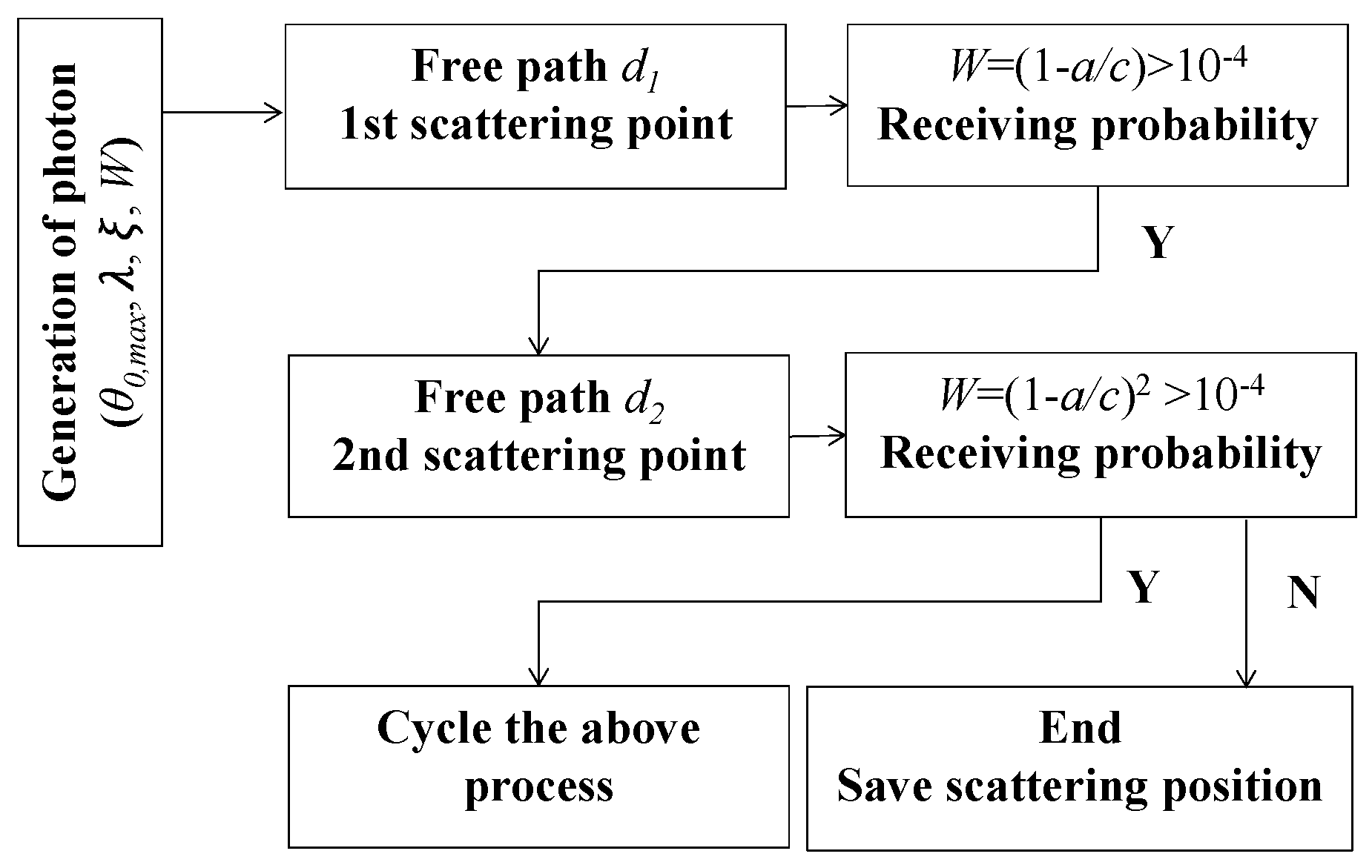


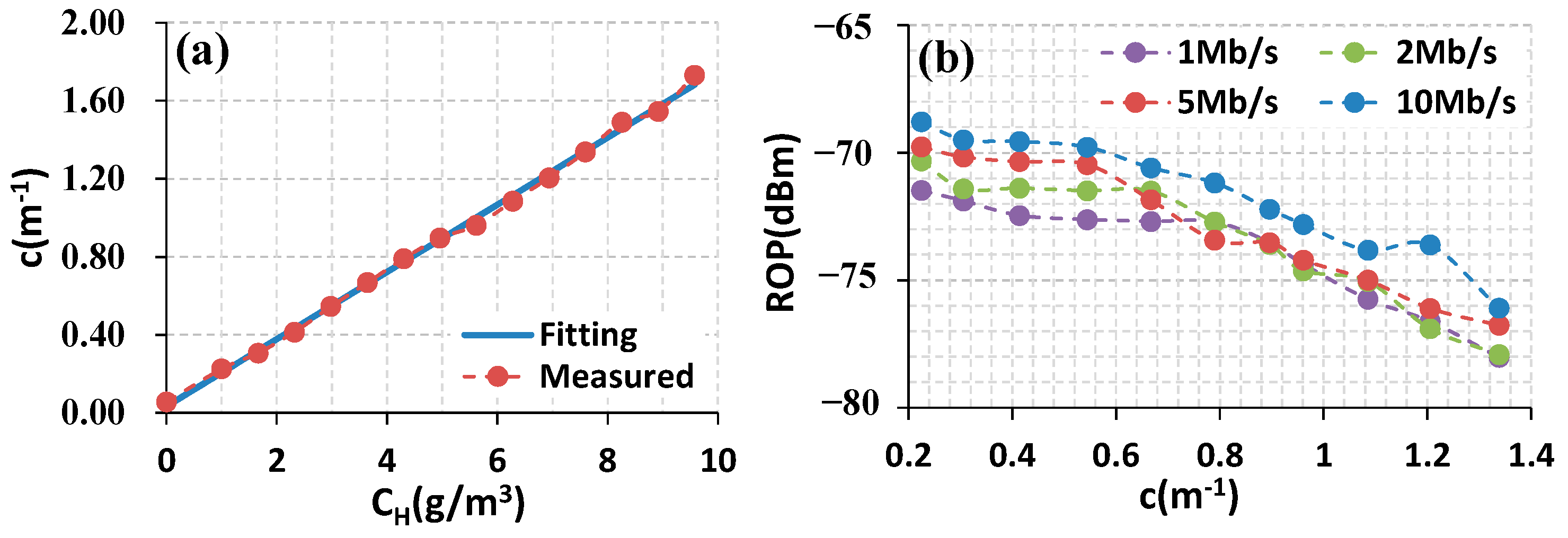

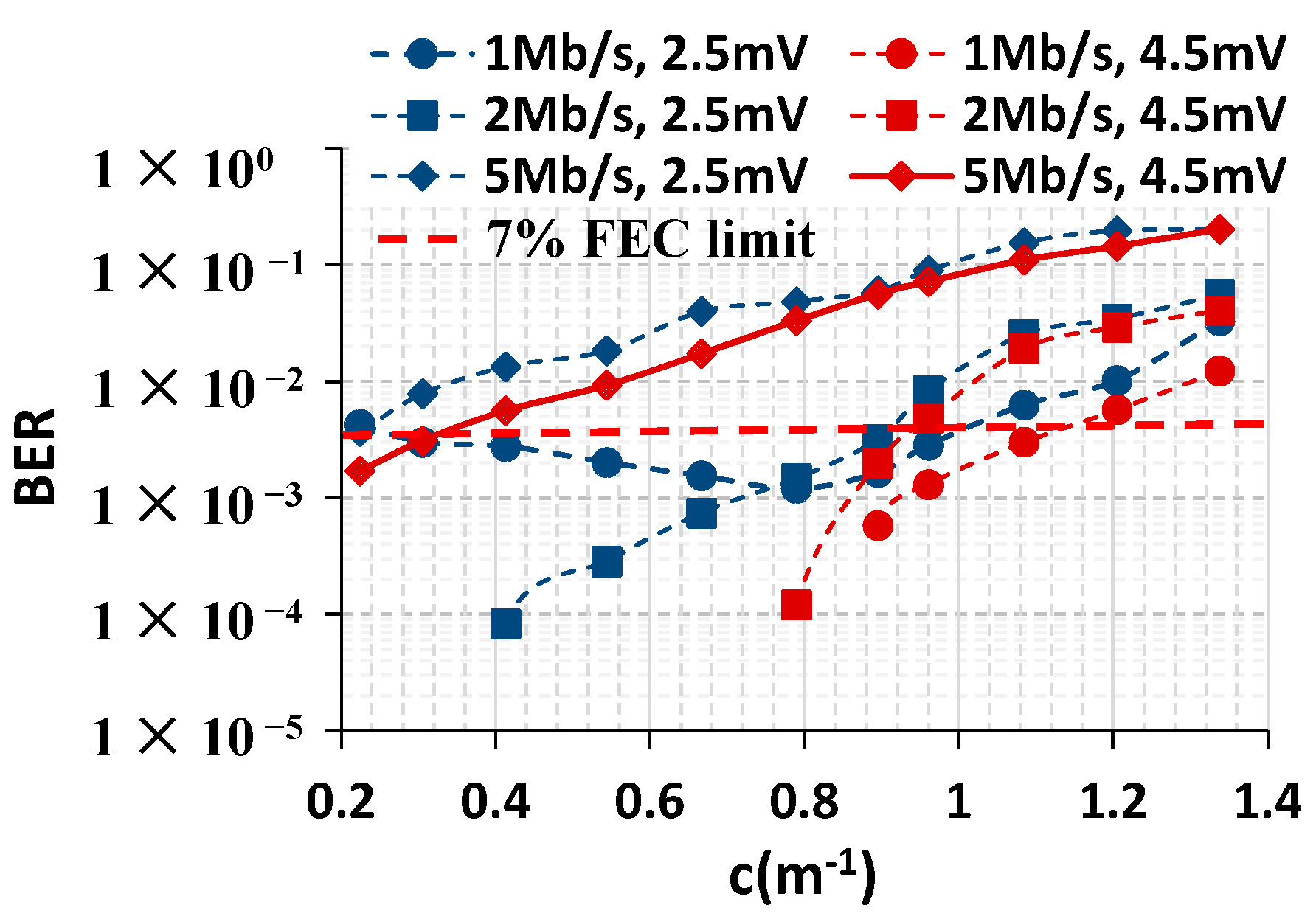
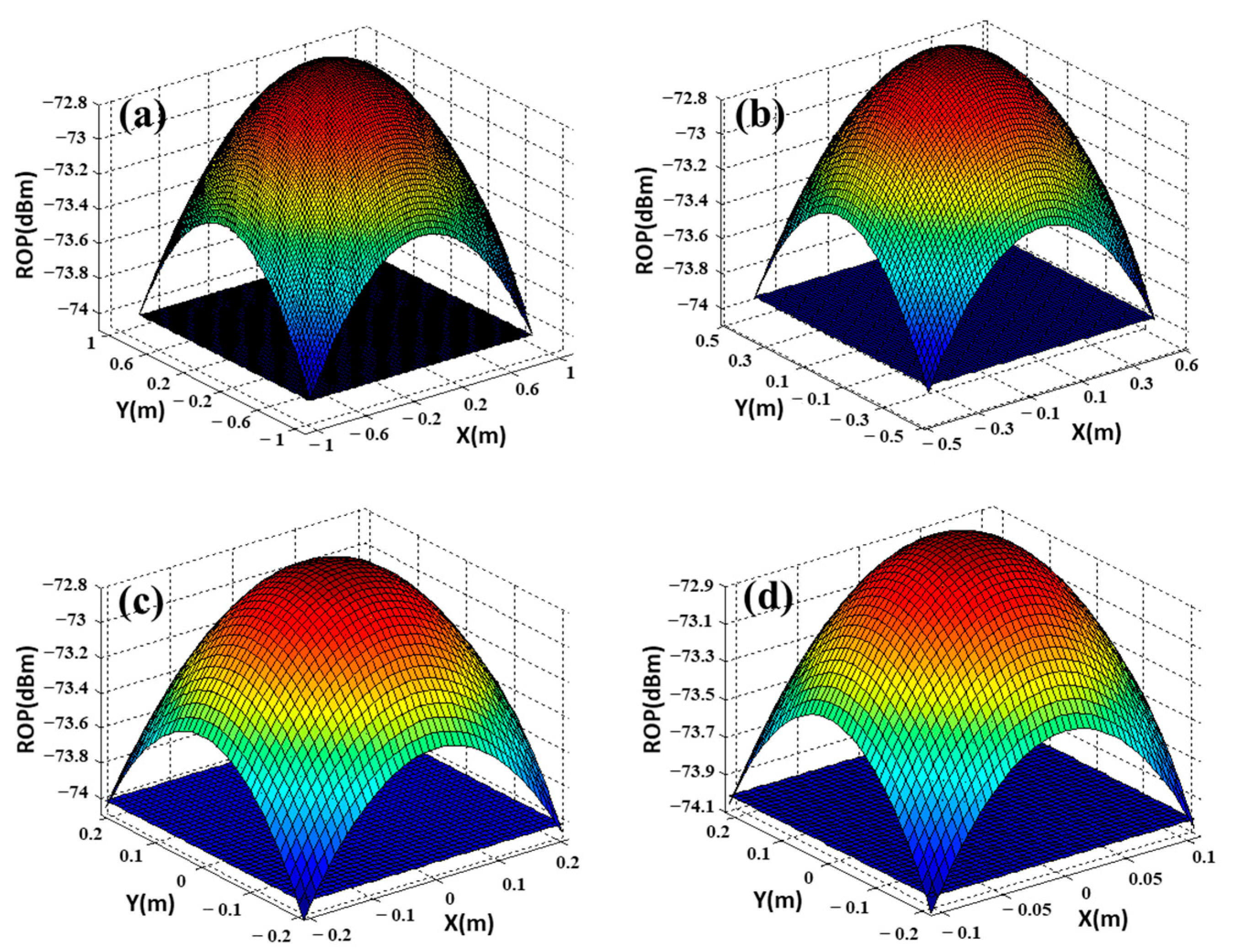

| Pure | Clean Ocean | Coastal | Turbid Harbor | |
|---|---|---|---|---|
| Cc | 0 | 0.31 | 0.83 | 5.99 |
| Symbol | Physical Meaning | Value |
|---|---|---|
| Incident optical wavelength (unit: nm) | 400, 450, 500, 550, and 595 | |
| Initial maximum half-divergence angle (random generation within []) | 8.2° | |
| Statistical random variable for free path (random generation within (0, 1]) | 0.6 | |
| Decision weight at the receiver | >10−4 |
| Symbol | Physical Meaning | Value/Unit |
|---|---|---|
| m1 | Lambertian order | 2.9 × 103 |
| Angle of irradiance | 5° | |
| Half-power semi-angle of LED | 1.25° | |
| z | Transmission distance | 10 m |
| E/O conversion efficiency | 0.1289 | |
| Pt | Transmitted electrical power | 1 W |
| Rb | Transmitted data rate | 1/2/5 Mbps |
Publisher’s Note: MDPI stays neutral with regard to jurisdictional claims in published maps and institutional affiliations. |
© 2021 by the authors. Licensee MDPI, Basel, Switzerland. This article is an open access article distributed under the terms and conditions of the Creative Commons Attribution (CC BY) license (https://creativecommons.org/licenses/by/4.0/).
Share and Cite
Li, C.; Liu, Z.; Chen, D.; Deng, X.; Yan, F.; Li, S.; Hu, Z. Experimental Demonstration of High-Sensitivity Underwater Optical Wireless Communication Based on Photocounting Receiver. Photonics 2021, 8, 467. https://doi.org/10.3390/photonics8110467
Li C, Liu Z, Chen D, Deng X, Yan F, Li S, Hu Z. Experimental Demonstration of High-Sensitivity Underwater Optical Wireless Communication Based on Photocounting Receiver. Photonics. 2021; 8(11):467. https://doi.org/10.3390/photonics8110467
Chicago/Turabian StyleLi, Chao, Zichen Liu, Daomin Chen, Xiong Deng, Fulong Yan, Siqi Li, and Zhijia Hu. 2021. "Experimental Demonstration of High-Sensitivity Underwater Optical Wireless Communication Based on Photocounting Receiver" Photonics 8, no. 11: 467. https://doi.org/10.3390/photonics8110467
APA StyleLi, C., Liu, Z., Chen, D., Deng, X., Yan, F., Li, S., & Hu, Z. (2021). Experimental Demonstration of High-Sensitivity Underwater Optical Wireless Communication Based on Photocounting Receiver. Photonics, 8(11), 467. https://doi.org/10.3390/photonics8110467








